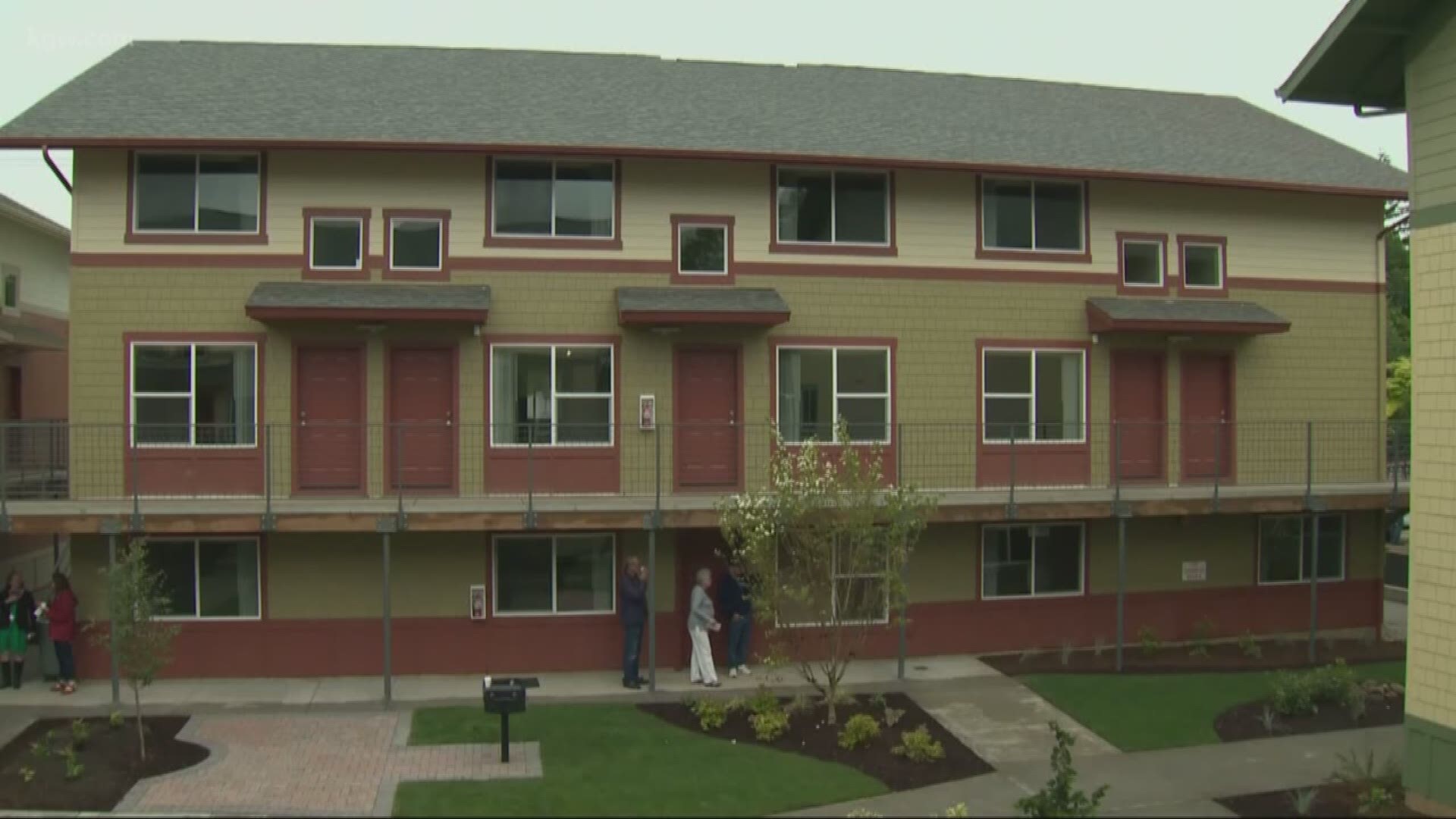Read Part 1 of this series: Why are new apartments so expensive?
Everyone in Portland seems to have an idea for making new apartments cheaper.
In part one of this two-part series, we looked at what cost factors drive the price of rent in a new apartment building in Portland. We examine nine things that could be done — or that could inadvertently happen — to bring those rents down.
Some of the considered scenarios (like a sudden outflux of residents from Portland) are fanciful, at least in the near term, but give useful context. Others (like easing restrictions on where apartments can be built) are matters of current political debate.
But taken together, what these figures show is where the biggest potential savings are. If we’re trying to bring down housing costs, this comparison helps us see which policy changes could deliver meaningful savings — and which couldn’t.
But how much could each of these proposed solutions really save? We ran hard numbers on nine scenarios that would save costs on a typical apartment that today rents for $2,000 per month. Some are unlikely, others may be impossible, and at least a couple have serious downsides. But all have come up in public discussions as Portland has debated its housing problem.
1. Let developers spread out fee payments: $8/month
Alex Joyce of the planning firm Fregonese Associates says Portland could save everybody money with one small change: letting buildings pay their system development fees gradually instead of up front. “You’ve just got to go in and cut a big, fat, painful check for transportation, for water, for parks. All of that stuff. But if you can finance it for a period of time — for 10 or 20 years, you’re making semiannual payments to the city with an interest rate applied — then that is really good for your books.”
This could shrink building loans and make more projects happen, but the direct cost impact is just $8 per unit per month.
2. Make Portland’s building permit process as efficient as Houston’s: $13/month
For a project like the Cordelia Apartments in Northwest Portland, every day a building permit awaits approval adds $2,649 in interest to a project that will have to pay back its investors ... and, therefore, about 10 cents toward the future monthly rent of each new apartment. Over the past 15 years, Portland’s large apartment buildings took, on average, 194 days to review. That’s because each permit must be reviewed by 13 separate groups or bureaus, each with its own stack of rules. The back-and-forth takes months. So we got numbers from Houston, which in 2015 redesigned its system so all city staffers could review plans digitally and simultaneously. Over the past three years, the slowest of Houston’s 5,974 new commercial building permits took just 28 days to process. If that were Portland’s average, the monthly rent at the Cordelia for Robert Cheney, who we introduced in part one of this series, might be $13 less.
3. Use cheaper materials: $17/month
Wood countertops instead of granite. Plastic bathroom fixtures, not chrome. Cheap fridge. But even the most skinflint developer would struggle to shave more than $17 a month from the final rent by skimping on frills — that’s why so many new buildings go the other direction and splurge on small stuff.
“Lipstick is cheap,” says Noel Johnson, a developer for Cairn Pacific.
4. Get investors to demand smaller returns: $27/month
Kevin Cavanagh of Guerrilla Development says he’s fascinated by the idea that business leaders should be ruthless profiteers at work, then make up for it with charity. “You would club baby seals with your left hand and build an orphanage with your right hand — that’s how it used to work,” he says. But the local developer says he’s trying to upend that approach with a new project on Northeast Sandy Boulevard. Atomic Orchard, a mixed-use development with 86 rental units, is giving his investors lower rates of return and using the savings to include 18 below-market-rate lofts for people “working on the front lines of homelessness in Portland.”
Investors “can give me money, and they can do social good,” Cavenaugh says. A Portland where all investors asked for only 15 percent returns on early, risky real estate investments (rather than a more standard 25 percent) would be a Portland where the average apartment would cost about $27 less per month.
5. Reduce car ownership: $31/month
Each parking space, including the aisles to reach it, eats up 350 square feet of space — more than a bedroom. Even in inner Northwest Portland, the going rate of $175 per underground spot doesn’t cover the cost of excavation and construction, so the rest comes out of everyone’s rent. If fewer people had cars on site — say, one car for every five rooms instead of three for every five — the garage could be smaller and average rent could be $31 lower.
6. Pay development pros like elementary school teachers: $35/month
Do developers really need an average of $175,000 in annual pay? Does the average architect really need $75,610? We imagined a world in which every developer and real estate consultant earned no more than the average Oregon elementary teacher: $65,250. If that happened, it could cut the rent by about $35 a month.
7. Reduce public services: $94/month
Portlanders tend to support taxes. But taxes do affect rents. Slicing local property tax millage to the rate in Roseburg — which drew national attention last year for voting to close its last public library rather than hike taxes — could save $94 in monthly rent.
8. Re-legalize small apartment buildings: $148/month
Two-story wood-frame apartment buildings were Portland’s answer to its 1900s and 1940s housing booms for a reason: They’re the cheapest construction process yet devised. But in 1959, Portland declared them incompatible with low-density residential zones. If we wanted, we could re-legalize so-called garden apartments in R5 zones. New apartments of a given size in a two-story wood building instead of a five-story concrete-and-wood one would slice construction costs from $193 to $157 per square foot, shaving rent checks about $148. One catch: Robert Cheney might find his home at, say, Southeast 26th Avenue and Lincoln Street instead of Northwest 19th and Johnson.
9. Reverse Portland’s population growth: $253/month
Portland’s modern growth spurt started in 1987; the population has grown more or less steadily since. But no city grows forever. Someday our bust will come, jobs and people will drift away, and we’ll see what a real housing surplus looks like. To illustrate the impact that a radical reversal in Portland’s population-growth rate would have on rent prices, we slashed the cost of commercial land from the current $250 per square foot to $13 — the going rate for commercial land in Toledo, Ohio, a city that in 1980 was roughly the same size as Portland but is now shrinking. That cost savings would knock about $253 off a rent check — and Portland would have a different set of problems to deal with.
Total savings: $625
Approximate price of a $2,000 apartment if all of the above-listed savings could be applied: $1,375 per month
THE CAVEATS
For the sake of simplicity, this project makes an important assumption.
We assume that if developers save money on a project, they’ll pass on the savings to future tenants by lowering the rent.
In the short term, only the saintliest developers actually would do this. If other new buildings in the area still were charging $2,000 for a one-bedroom apartment, most developers would charge the going rate and pocket the difference.
But the figures in the graphic start to matter in the long run. Every several years in a growing city, ambitious developers tend to build a bit faster than population growth — eventually forcing rents down slightly as property managers scramble to fill empty rooms. But then, as soon as developers realize rents have fallen, building slows until rents rise again.
It’s a boom-bust cycle that creates housing shortages like the one that started in Portland seven years ago.
For tenants, the effect is that unless there’s a local economic collapse, rents in private-sector buildings mostly go up, almost never down.
But this system, perverse as it is, does have an escape hatch: lowering costs. If development costs fall, developers can keep “overbuilding” longer than they otherwise would because they can keep turning a profit despite lower rents. This drives rents permanently lower in all buildings before the cycle begins again.
“We’ll overbuild a little bit more,” says Portland-based housing economist Jerry Johnson of Johnson Economics. “Basically, rents are really set by replacement cost, and that’s why it’s important in the long term to keep replacement costs low.”
... And when they don’t
There’s one other limitation of this project. You already may have noticed it.
Even with all the economic and policy changes imagined here, we only managed to get the price of a newly built one-bedroom apartment down to $1,375 per month.
If you were a 40-hour-a-week restaurant cook who makes $12 per hour, you might take home $1,600 a month after taxes. For you, that $1,375 rent might as well be $2,000. You couldn’t afford either amount.
That’s the other great challenge of modern housing: It’s essentially impossible to build housing to today’s standards cheaply enough for poor people to afford a newly built apartment.
That leaves two places where the poorer half of the U.S. population can live: publicly subsidized homes or buildings that are not new.
As they age, Johnson says, older rental buildings tend to become gradually cheaper ... but only if tenants willing to pay more can find more desirable places to rent instead.
And eventually, older buildings get replaced — like the two-story office building on Northwest 19th Avenue that was torn down in 2013 to make room for the Cordelia Apartments.
Robert Cheney, a Cordelia resident, says he feels a little bit guilty to be part of that cycle.
“I don’t want to contribute to the whole situation of new buildings going up and maybe chipping away at the character of this old neighborhood,” he says. “But at the end of the day, you’ve got to live somewhere.”
Michael Andersen is a Portland-based urban policy reporter. This story is part of an investigative series produced by the Open: Housing Journalism Collaborative, a joint project of the University of Oregon’s Agora Journalism Center, Pamplin Media Group and KGW-TV. Look for other stories in this and related series at OpenHousing.net.
Note: Both costs and rents used in this series are expressed in 2018 dollars. To see the spreadsheet we used, visit pdx.be/ProForma.




